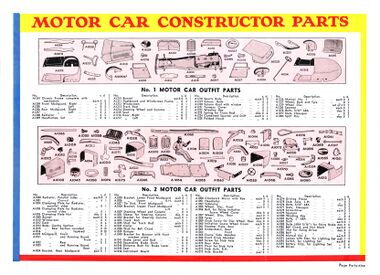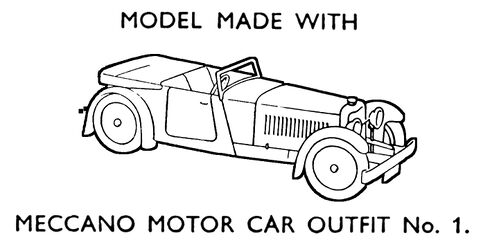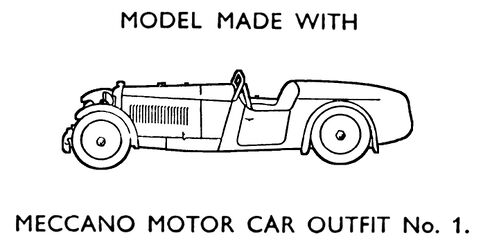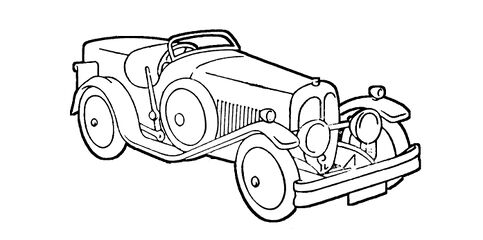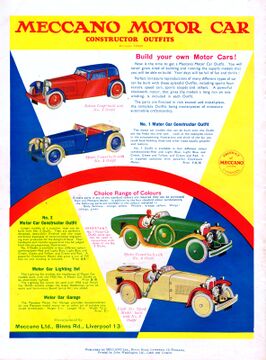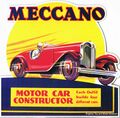Category:Meccano Motor Car Constructor
Meccano/Hornby/Dinky :
Mechanics Made Easy | Meccano | Super Models | Motor Car Constructor | Aeroplane Constructor | Dinky Builder | X-Series | Plastic
W UK US FR DE 1900s | 1910s | 1920s | 1930s | 1940s | 1950s | 1960s | 1970s |
| Toy Brands and Manufacturers |
|---|
Meccano Motor Car Constructor |
| Constructor - No.1 - No.2 |
| 1932 - 1939 |
Full-page spot colour advert, August 1932 [image info]
1933: full-double-page spread advert [image info]
1933: "Have the thrills of Brooklands in your own home!" [image info]
Meccano Garage [image info]
1935: Special parts for the Motor Car Constructor outfits [image info]
1938: Motor Car Constructor ad [image info]
The Meccano Motor Car Constructor sets started to appear in 1932, as a followup to the successful Meccano Aeroplane Constructor outfits the previous year.
Meccano Ltd understood that although Meccano was successful, it wasn't for everyone. Some people wanted to build model cars, but didn't didn't necessarily want the results to look like Meccano models. While Meccano tried to be logically faithful to the original objects, the results were always primarily Meccano models, and there was also an argument that although Meccano was perfect for building scaffolded structures such as cranes, and nuts and bolts items like mechanisms and machines, that perhaps it wasn't so faithful in an engineering sense for building model motorcars, where the originals invested much of their character in smooth streamlined body panels.
Like the "Aeroplane" sets, the Motor Car sets consisted mostly of custom parts (that allowed a range of car variations), and again, like the aeroplane sets, the smaller outfits weren't compatible with the larger ones. There wasn't always a huge variation between some of the smaller models, and sometimes the biggest visible difference was whether a spare wheel was attached to the rear of the side.
Outfit No.1 and Outfit No.2 were not compatible - No.2 produced larger cars (and cost around twice as much).
Example Models
No.1 Outfit models
No.2 Outfit models
note the larger size
Versions
The original 1932 Motor Car Constructor
- The system originally launched with just one version, which seems to have been pretty close to the subsequent No.2 Outfit.
The Motor Car Constructor Outfit No.1 (1933)
- In 1933, Meccano Ltd brought out smaller version of MMCC, for half the price, and called it the No.1 Outfit.
The Motor Car Constructor Outfit No.2 (1933)
- The original MMCC Outfit, with some changes, then became the No.2 Outfit.
- The new No.2 Outfit was now designed to be retro-fittable with electric headlights. The new lighting kit could still be fitted to the original 1932 outfits if one purchased the updated No.2 dashboard and headlights separately.
Pre-built versions
- Some of the standard models from the No.1 and No.2 Outfits could also be purchased ready-built.
- These were priced at a similar price (or the same price) as the kits. Although the prebuilt cars obviously required more labour time at the factory for assembly, the prebuilt models didn't include the redundant alternative parts that came with the kits, and where the "outfits" came in a large flat display box with the parts laboriously strung to a backing card, the prebuilt cars came in a simpler, cheaper, non-glossy blue box.
The Meccano Two-seater Sports Car
- Also in 1933, Meccano Ltd produced a smallish clockwork car comparable in size to the No.1 set cars, but not disassemblable. While this couldn't be customised, it also didn't have big out-of-scale bolt-heads spoiling the line of the bodywork.
- Although this was not a constructor outfit, it didn't really fit in with any of Meccano Ltd.'s other ranges, so it was advertised alongside the MMCC products.
Full-page advertising
Accessories
Motor Car Lighting Set
A wiring kit with tiny headlight bulbs that could be fitted inside an MCC No.2 car, and powered by a 3 Volt battery.
Motor Car Garage
- " The Meccano Motor Car Garage provides accomodation for any Meccano model motor car or any other car of suitable size. It is strongly built, with imitation rough-cast finish, and adds the final touch of realism.
- Inside dimensions: Height 5 in. Length 13 in. Width 7 3/4 in. Price 5/6
1932 promotional text:
Building Your Own Motor Cars!
The New Meccano Constructional Outfit
THE motor car is one of the most fascinating examples of modern mechanical development. The thrill of high-speed travel on road or track is rivalled only by the aeroplane, and the actual design and construction of a motor car provide an almost unlimited store of interest and education. Nowadays there are very few people who are not interested in some way in motor vehicles, and even those who do not actually own cars have a good idea of the principles on which they operate, and are able to pick out the best-known makes by noting their distinctive external features.
It is natural that cars should make a particularly strong appeal to Sleccano enthusiasts, and their great popularity among model-builders is shown by the large numbers of cars that are submitted in every possible "M.M." building contest. Meccano is splendidly adapted for building the chassis of a model motor vehicle, and the Meccano Chassis, Super Model No. 1, is a good example of the accuracy with which the mechanical features can be reproduced. The chassis does not by any means form a complete vehicle, however, for the bodywork and external features play an important part in the general scheme. Standard Meccano parts have certain limitations when employed for this purpose in model car construction, and for that reason there have been produced the Meccano Motor Car Constructor Outfits. These Outfits enable strikingly realistic models of sports and speed cars to be built – each one a masterpiece of design and workmanship.
In the Motor Car Constructor Outfits the interchangeability of standard Meccano parts has been retained, with the result that the builder can vary his designs according to his own ideas. The individuality of the models thus made possible is further increased by the introduction of three distinctive colour schemes for the bodywork of the models, so that the model motor builder may obtain an Outfit with which to build cars in the colours that attract him most.
In the first of these colour schemes the bodywork of the car is in green enamel, the mudguards and running boards are in cream enamel, and the seat is in bright red "crackle" lacquer that gives it a very leather-like appearance. The second colour combination has the bodywork of the car in brilliant red, the wings cream, and the seat section in blue ; and in the third scheme the body is enamelled blue, the wings are cream, and the seat section has red finish. To add to the smart effect of these colour schemes, the radiator, bumper bar, lamp rings and brake lever are all chromium-plated, and the realistic disc wheels and the honeycomb portions of the radiators are coloured red. The appearance of a Meccano car built in any of these colour schemes is extremely smart and the completed model is remarkably like the real thing
We must now leave the external appearance of the cars to deal with some of the outstanding mechanical details. Ackermann-type steering gear is provided for the front wheels, with worm and nut actuating mechanism, and there is a strongly built clockwork motor drive for the rear wheels. The steering gear has been carefully designed to enable an extremely delicate adjustment of the front wheels to be made by rotating the steering wheel placed in the dash. The front wheels are mounted on stub axles pivoted to the sides of the chassis frame of the model. The stub axles are provided with extension arms connected together by means of a track rod, which in turn is coupled to a bell crank with a nut block attached to this crank. The end of the steering column is threaded so that it may work inside the threaded hole in the nut block, and thus there is obtained in the Meccano car a very close copy of the worm and nut gear that is used on many actual cars.
When the steering wheel is rotated the threaded end of the steering column draws the nut block up or down, and consequently the bell . crank to which the nut block is attached is actuated. The bell crank carries a pin that engages with a slot in the centre portion of the track rod, and movement of this pin causes the track rod to be moved to one side or the other. As the track rod is coupled to the stub axles on which the front wheels are mounted, any movement of it will cause the road wheels to be swivelled, so that the model can be made to travel in either a right-hand or a left-hand direction. The accuracy with which this ingenious gear operates will be found particularly useful when it is required to set the model travelling on a curved course. By rotating the steering wheel it is possible to direct the car so that it will pass round various obstacles.
A specially designed clockwork power unit is provided for the Meccano car models, the clockwork mechanism being produced on similar lines to the famous mechanisms that have contributed so largely to the world-wide success of Hornby Trains. This motor, however, has been designed with special regard to the particular requirements of a model racing car, and it incorporates a spring that gives a remarkably powerful drive at high speed, together with an exceptionally long run. When fully wound the motor drives the car for a distance of 150 ft. at a scale speed of approximately 100 mph. !
Another interesting mechanical feature is the brake mechanism. This is of the internal expanding type, and is controlled by means of a brake lever mounted on the outside of the body at the right-hand side of the dash. The mechanism of the brake is particularly ingenious, and it provides an effective braking action on the clockwork motor while the latter is being wound up, and when the car is required to be kept at rest on the ground.
The brake gear consists of a drum having a split rim and a special tapered cam that is pivotally connected to the brake lever, which in turn is mounted pivotally against the side of the body. The rear road wheel, which is die-cast from special metal, is provided with a circular recess, and into this the rim of the brake drum fits. The tapered actuating cam is pushed into position between the split rim of the drum, and the control lever is arranged so that when in the forward position the brake is "off." To apply the brake the lever is drawn back, and the tapered cam then comes into action and forces the split rim of the brake drum outward. The rim then makes contact with the circular recess in the rear wheel and the friction results in a powerful braking action.
The addition of correct-type steering and braking mechanisms enables a series of interesting operations to be carried out when preparing the model "for the road." The brake lever is first of all drawn back so that the brake is applied fully. The clockwork motor is now wound up by means of the key provided, and the complete car is placed on the ground. If the car is desired to travel forward in a straight line, the steering wheel is rotated so that the front wheels are exactly in line with the rear pair; while movement of the wheel to either the right or the left will result in the car describing a curved path in its run. After the steering has been adjusted the brake lever is moved into the forward position, thus releasing the rear wheels, and the car will then move off gradually, gathering speed until it is "flat out"! The car will travel at speed for the full 150 ft. The best results as regards speed and length of run are obtained when the model is run on a concrete, tar macadam, or other surface that is both smooth and hard.
Turning once again to the external fittings and features of the cars, it will be noticed that two distinct types of radiators are included. These are interchangeable, so that either may be fitted to the model as required. The radiator fitted to the car shown in Fig. 1 is of graceful modern design. It has curved sides, and a " centre line," which is an outstanding feature in the design of actual modern radiators. The radiator incorporated in the car shown in Fig. 2, on the other hand, has parallel sides, and the general sturdy lines of the powerful British speed car that the model represents. Two types of rear body section are also supplied, one being of the rounded pattern as shown in Fig. 2, and the other of graceful streamline tapered type, Fig. 3. The wheelbase and overall length of the car can be altered as required. The car shown-in Fig. 1 is a short wheelbase type, while the models illustrated in Figs. 2 and 3 have long wheel-bases.
Another very interesting variation in the arrangement of the Constructor parts is in building a light six-cylinder speed machine. Modern racing cars are classified in accordance with the total cubic centimetre capacity of the cylinders of the engine. The "baby" M.G. Midget thus comes in the 750 cc. class, which means that its engine has a total cylinder capacity of 750 cubic centimetres. Many light racing machines, however, have engines with capacities between 1,000 and 1,500 c.c.
Popular British cars in the "light racer" class are the Riley, Fraser-Nash and the Aston-Martin. Among the famous French cars of this type are the Amilcar, Salmson, and Bugatti, while numerous light racing cars are manufactured by Italian, German, and other Continental concerns.
It is possible to build a very realistic model of this kind with the Meccano Motor Car Constructor Outfit. Unfortunately it has not been possible to include an illustration of this model here, but it may be said that the model incorporates many of the features of a real light racing machine and is of the short wheelbase type.
Full constructional details for building each of the fine models mentioned in this article are contained in a new Instruction Manual included in each Motor Car Constructor Outfit. The constructional details are made clear by means of numerous illustrations, so that no difficulty should be experienced in reproducing any of the models described.
— , -, , "Building Your Own Motor Cars!", , Meccano Magazine, , October 1932
1933 promotional text:
Model Motoring For All
The Fascinating Meccano Car Constructor
AT this time of the year Meccano boys begin to think of outdoor sports and amusements, and the keen model-builder naturally looks for some open-air pastime or hobby that will take the place of his indoor model-building activities. Nowadays there is a big variety of outdoor recreations, but undoubtedly one of the most fascinating is model car operation with cars built from Meccano Motor Car Constructor Outfits. Many thousands of Meccano boys are proud possessors of these Outfits, but although they obtain a great deal of fun by running their cars indoors, probably many have not realised the wonderful possibilities that the use of the car out of doors affords.
A Meccano Motor Car Constructor Outfit actually provides an ideal hobby for the Spring and Summer months, as it enables many fascinating hours to be spent in the open air operating the models built with the Outfit, while at the same time it provides the model-builder with constructional work when it is not possible to be out of doors. Many interesting racing events, competitions, experiments, etc., can be arranged for the models, and in this article we deal with this interesting aspect of Meccano model motoring. Some useful hints regarding construction and adjustment are also included, so that constructors may obtain the maximum efficiency from their cars.
The Meccano Motor Car Constructor, although introduced only last year, has already achieved remarkable popularity, and a big proportion of our readers will now be familiar with its general design. For the benefit of those who are not, however, we include a short description of the Outfit and the different speed cars that can be built by means of it.
Each Motor Car Constructor Outfit contains a complete set of miniature automobile parts with which realistic models of sports and speed cars may be built. Some of the parts in the Outfit are enamelled in colours, while others are chromium plated, so that a car built up from the Outfit has a particularly handsome appearance.
The realistic effect has not been achieved at the expense of adaptability, however, as many of the parts, such as body sections, Mudguards, Radiator, Spare Wheel, may be changed so as to produce different types of cars. In addition it is possible to shorten or lengthen the wheelbase of the car, so that a model of a big sports tourer, or of a light speed model with a shorter wheelbase, may be assembled as desired.
The Meccano Motor Car Constructor can be obtained in four distinct colour schemes, red and cream, light blue and cream, green and yellow, and red and light blue, so that the model motor-builder may express his ideas in regard to the appearance of his models.
While the Meccano Motor Car has a particularly fine external appearance, the internal mechanical features and motor drive are nonethe less interesting. The steering gear is of the worm and nut type, the steering bell crank being connected to a track rod that is attached to the front road wheel stub axles in a similar manner to an actual car. The brake is of the internal expanding type operating on a drum on the rear wheel, and provides a very powerful braking action. The spring Motor with which the car is powered has been specially designed to provide a long run at high speed, and some idea of its efficiency can be gained from the fact that it will drive the model for a distance of 150 feet, at a scale speed of approximately 100 m.p.h. Full instructions for building up the car with the Motor Car Constructor parts are contained in the special Instructions supplied with the Outfit, and no difficulty should be experienced in assembling a model if the instructions are followed.
Before giving the completed car a trial run, the various moving portions should be inspected in order to make sure that they are adjusted correctly: A hall or passage may be used for running the car, but by far the most satisfactory type of "test ground" is a stretch of smooth concrete or asphalt. A garden path having a smooth hard surface is also suitable, but the car will not run well on a gravel or other loose surfaced track owing to the high frictional resistance between the wheels and the ground.
In addition, loose particles of gravel or sand are liable to enter the clockwork mechanism, with a detrimental effect on the running of the car.
To operate the model, first place the brake in the "on" position by drawing the Brake Lever toward the rear of the car. Then wind up the motor with the key provided and place the car on the ground. Next turn the steering wheel so that the front wheels are set for the car to run in the required direction, and finally release the brake by moving the brake lever into the forward position. The car will then commence to move forward, gradually gathering speed until it is running "flat out". It will continue to travel at top speed until the spring motor is practically unwound, when it will slow down and finally come to rest.
The length of run obtained with the model depends of course on the smoothness or otherwise of the ground, but it is affected also by the angle at which the front wheels are set. If the car is arranged to travel in a straight line, the full run of 150 ft. will be obtained on a good surface. On a circular course the length of run is reduced to some extent on account of the increased friction between the road wheels and the track.
If the steering wheel is turned so that full right-hand or left-hand lock is obtained, the car can be made to run in a very small closed circuit, but the friction in turning at such a sharp angle will reduce the speed to a considerable extent.
After the steering of the car and brake operation have been mastered fully, the constructor will be keen to enter his model in competition with model cars built by his friends. Some very exciting races can be arranged, and when several cars are entered in an "event," the effect is very thrilling.
For the best effect, a fairly large open space such as a concrete or asphalt playground is required, but where this is not available, "lap" races in which the model cars make a fixed number of circuits of a relatively short course can be staged with interesting results.
In an actual race the competing cars are lined up at the starting point, each one occupying a space marked off on the ground. Model-builders may reproduce this feature by marking out spaces on the ground in which the model cars must be placed before the commencement of the race; strips of white paper can be used for this purpose.
Several "course officials" should be appointed before the commencement of the race, and they are responsible for giving the starting signal and recording the winning car at the finishing end of the course, while they must also see that no "rules" are broken while the race is in progress. The cars may be started by "flagging off". A suitable flag can be made from paper or cloth, and this is held by the starter. At the required moment he lowers the flag, and the cars are started by their respective operators. A toy cap pistol may also be used for starting purposes.
A quick start is of vital importance in a model race, especially if the course is not a very long one, and each operator should therefore be ready to release the brake of his model on the instant the signal is given. The best way of doing this is to hold the car in position by resting the left hand on the rear portion of the bodywork, while the Brake Lever is held by the fingers of the right hand. The instant the starting signal is given the Brake Lever is pushed forward, thus releasing the rear axle, so that the model may speed away.
When a "lap" event is being run, the winner of the race cannot be identified as easily as in a straight circuit, as the model car that has completed the full number of laps may lie behind another car with a lower number of laps to its credit, the latter consequently giving the impression of being the winner. It is here that the "course officials" play their part by noting carefully the number of laps completed by each car entered in the race. The winning car may be "flagged in" with a chequered flag.
The various colour combinations in which the Meccano Motor Car can be produced will generally enable the different entries to be distinguished easily during a race. In a big race, however, in which many Meccano Cars are entered, it is a good plan to fix discs of white card to the sides of the bodywork of the cars, distinguishing numbers being painted on these discs in black. In doing this Meccano boys will be following actual motor racing practice, as the entries in big racing events are marked in this way.
Mention of distinguishing marks brings us to an addition that will give an individual touch to the car – the painting of registration numbers on the Front and Rear Number Plate of the machine. The Number Plates of the Meccano Motor Car are supplied blank, so that constructors may insert any number they desire. They may, for instance, fill in the registration number of their father's car, or of that of a friend who owns an attractive sports or racing machine. The figures may be painted on the Number Plates in Chinese white water colour, a fine brush being used so as to obtain a neat effect. If a more permanent result is desired, white oil colour mixed with a little turpentine may be used.
Turning once again to the subject of model races, some readers may be inclined to think that competitive events in which Meccano Cars are entered will result in "dead heats", owing to the fact that the motive power, steering mechanism, etc., are identical. This is not the case, however. All Meccano Cars when correctly assembled will have practically the same performance as regards speed and length of run, but the final adjustment and lubrication of the mechanism rests with the owner, and the model-builder who pays particular attention to the "tune" of his car will enable it to out-distance less well-adjusted models.
In tuning the car so as to obtain the maximum efficiency, the most important point is to, see that there is no stiffness in the drive from the Contrate on the spring motor to the road wheels. The Collars that hold the Rear Axle in position should be adjusted so that the Axle can turn freely; too much lateral play must not be allowed, however, as this will result in irregular running. The Driving Pinion mounted on the Rear Axle must engage the teeth of the Contrate smoothly, and in order to ensure that no slip takes place between the Pinion and the shaft, a depression is cut in the Axle, into which the grub-screw of the Pinion should be driven. For maximum speed there must, of course, be no retarding or braking effect, and it is therefore important to see that the drum of the internal-expanding brake does not touch the Rear Wheel at any point when the brake is in the off" position, with Brake Lever pushed forward.
If the brake mechanism has not been assembled correctly there will be a tendency for the Drum to press against the Wheel flange. This mechanism is assembled as follows. The end of the Brake Rod is first pushed into position in the Brake Drum by passing it between the securing flange and the rim, care being taken to see that the Brake Lever is on the inside of the Brake Rod when the unit is attached to the Car. The Lever is pushed forward until the narrow portion of the cam end is opposite the opening in the rim, and is then slipped into place. With the Drum held in one hand, the Brake Rod is drawn outward so that the second fixing hole in the lug of the Drum is uncovered. The Brake Drum is now bolted to the car by ¼" Bolts, which also serve to hold the Rear Mudguard Brackets in position.
The Brake Lever is mounted on the special 5⁄16" Bolt and held in place by means of a nut. In assembling the rear road axle, the right-hand Rear Wheel is first secured on one end of the Axle by means of its grub-screw, and the Axle is then pushed through the bearing in the right-hand side of the Frame, the Collars and Driving Pinion being slipped on before the Axle is pushed through the left-hand side of the Frame. Finally the left-hand Rear Wheel is mounted in place on the projecting end of the Axle.
The Meccano Car, like a real car, must be carefully lubricated from time to time in order to reduce friction and wear to a minimum. The special Meccano Oil should be used for this purpose, and this may be applied by means of either the No. 1 or the No. 2 Oilcan, the No. 2 Oilcan being particularly suitable for use with the car as it is a correct scale model of the actual" K "type engineer's oilcan used in many garages and motor works. Oil should be applied to the teeth of the Contrate Wheel and driving Pinion and to the Rear Axle bearings, and a little also to the steering gear and front road axles. Oil must not be allowed to reach the Brake Drum, as this will cause slipping.
Meccano model motoring would not be complete without some means of accommodating the car when not in use, and the Meccano Garage has been produced for this purpose. Another interesting addition is the Car Lighting Set, which enables the Headlamps of the model to be fitted with electric lights.
— , -, , Model Motoring For All, , Meccano Magazine, , May 1933
See also:
External links
Subcategories
This category has the following 3 subcategories, out of 3 total.
M
- Meccano Motor Car Constructor No1 Outfits (1 P, 10 F)
- Meccano Motor Car Constructor No2 Outfits (1 P, 12 F)
T
Pages in category ‘Meccano Motor Car Constructor’
The following 5 pages are in this category, out of 5 total.
Media in category ‘Meccano Motor Car Constructor’
The following 42 files are in this category, out of 42 total.
- Building your own motor cars, p776 (MM 1932-10).jpg 1,204 × 1,617; 490 KB
- Building your own motor cars, p777 (MM 1932-10).jpg 1,605 × 2,156; 690 KB
- Colouring-in sheet - Meccano Car.jpg 3,508 × 2,482; 889 KB
- Grand Prix Special (Meccano Motor Car Constructor 2).jpg 2,556 × 1,077; 375 KB
- Green clockwork Tourer (Meccano Motor Car Constructor 2).jpg 3,000 × 1,200; 430 KB
- Light Six Speed Car (Meccano Motor Car Constructor 2).jpg 2,556 × 1,065; 338 KB
- Light Sports Two-Seater (Meccano Motor Car Constructor 2).jpg 2,556 × 1,065; 394 KB
- Meccano Garage (MCat 1934).jpg 1,600 × 835; 305 KB
- Meccano Motor Car Constructor (MM 1932-08).jpg 1,177 × 1,600; 398 KB
- Meccano Motor Car Constructor (MM 1933-09).jpg 1,182 × 1,600; 410 KB
- Meccano Motor Car Constructor (MM 1933-10).jpg 1,188 × 1,600; 515 KB
- Meccano Motor Car Constructor (MM 1935-06).jpg 1,156 × 1,582; 376 KB
- Meccano Motor Car Constructor (MM 1935-08).jpg 1,172 × 1,600; 437 KB
- Meccano Motor Car Constructor (MM 1939-04).jpg 2,408 × 3,122; 894 KB
- Meccano Motor Car Constructor (MM 1939-12).jpg 915 × 1,200; 200 KB
- Meccano Motor Car Constructor Outfits (MM 1938-11).jpg 2,301 × 1,601; 635 KB
- Meccano Motor Car Constructor Outfits fullpage (MM 1936-10).jpg 1,204 × 1,617; 385 KB
- Meccano Motor Car Constructor Parts (1935 BHTMP).jpg 1,663 × 1,204; 391 KB
- Meccano Motor Car Constructor, double-page spread (MM 1933-09).jpg 3,000 × 2,022; 1.14 MB
- Meccano Motor Car Constructor, double-page spread (MM 1933-10).jpg 3,000 × 1,994; 1.15 MB
- Meccano Motor Car Constructor, shop point-of-sale sign.jpg 1,600 × 1,569; 445 KB
- Meccano Motor Car Outfit No1 (1939 catalogue).jpg 685 × 837; 77 KB
- Meccano Motor Car Outfit No2 (1939 catalogue).jpg 703 × 1,115; 104 KB
- Meccano Motor Car, box end.jpg 2,200 × 1,795; 746 KB
- Meccano non-constructional Sports Car (MM 1936-06).jpg 1,166 × 1,526; 292 KB
- Meccano Two-Seater Car, Instructions (1934).jpg 1,342 × 1,600; 911 KB
- Meccano Two-Seater Sports Car (MCat 1934).jpg 2,400 × 1,039; 468 KB
- Meccano Two-Seater Sports Car (non-constructional) (1939 catalogue).jpg 993 × 671; 114 KB
- MMCC No1 example 01 (MM 1933-09).jpg 1,394 × 693; 111 KB
- MMCC No1 example 02 (MM 1933-09).jpg 1,394 × 693; 99 KB
- MMCC No1 example 03 (MM 1933-09).jpg 1,394 × 693; 98 KB
- MMCC No2 example 01 (MM 1933-09).jpg 1,394 × 693; 108 KB
- MMCC No2 example 02 (MM 1933-09).jpg 1,394 × 693; 121 KB
- MMCC No2 example 03 (MM 1933-09).jpg 1,394 × 693; 111 KB
- Motor Car Constructor Outfit No1 (MCat 1934).jpg 2,200 × 1,601; 780 KB
- Motor Car Constructor Outfit No2 (MCat 1934).jpg 2,000 × 1,461; 718 KB
- Road Racer (Meccano Motor Car Constructor 1-3).jpg 1,600 × 647; 180 KB
- Saloon Coupe (Meccano Motor Car Constructor 1-2).jpg 1,600 × 690; 155 KB
- Sports Tourer (Meccano Motor Car Constructor 1-4).jpg 1,600 × 659; 196 KB
- Sports Tourer (Meccano Motor Car Constructor 2).jpg 2,556 × 1,070; 398 KB
- Sports Tourer with Hood (Meccano Motor Car Constructor 1-1).jpg 1,600 × 639; 166 KB
- Two-Seater Sports Car (Meccano non-constructional) (MM 1936-10).jpg 767 × 1,007; 219 KB





